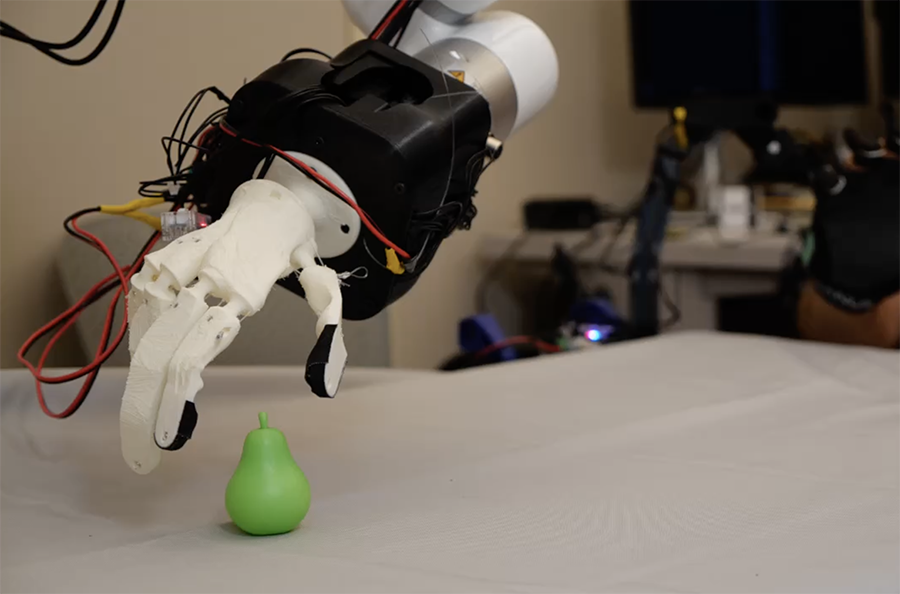Biology Inspires Robotic Arm in NSF-Funded Project Researchers Hope To Improve Prosthetics for People With Limb Differences
Marylee WilliamsThursday, October 10, 2024Print this page.

For people who use a prosthetic arm, everyday tasks such as picking up small objects or readjusting their grasp on a pen can present a huge challenge. This inability to do the basic tasks of a biological arm often leads people to abandon their prosthetics. In fact, some research on upper limb prosthetics suggests that up to one in five people will stop using them.
Nancy Pollard, a professor in the School of Computer Science's Robotics Institute (RI) and Computer Science Department, has joined forces with researchers from across the country to create better prosthetics by taking cues from the anatomy of the human arm and hand. A biologically inspired arm could ease the frustration of people living with prosthetics, causing fewer to abandon them. The technology could also be applied to manufacturing and agriculture.
"In our research, we're working with a nurse anesthetist who can't pick a pen up off the table with his prosthetics," Pollard said. "Something as simple as that is just too hard, and it shouldn't be. You see all these flashy prosthetic hand videos in the news and on YouTube, and it looks like hands are so capable right now, but they're not. There are a lot of simple things that they can't do. We'd like to be able to do those kinds of things and capture some of the subtleties of how the hand moves."
The National Science Foundation (NSF) provided a grant to support this project, which the research team named Altus Dexterity to reflect the high level of dexterous behavior their work targets.
The subtleties of the human hand come from the skeleton, muscles, tendons, skin and sensing across the extremity. Joohyung Kim, an associate professor at the University of Illinois Urbana-Champaign, is working on waterproof skin and sensing. Kim completed his postdoctoral fellowship at Carnegie Mellon University, and said he signed onto the project because he's interested in creating a better design for a hand than what's currently available.
"My research is in humanoid robotics, making a humanlike robot, and I spent more than six years at Disney where I found that the aesthetic and character — the humanlike part — is super important," Kim said. "Our goal is to make a prosthetic hand that can also be used for manufacturing. We're aiming for functionality and a very humanlike appearance. But reengineering a human hand is incredibly hard."
Pollard's lab captured detailed videos of how a human hand grasps and manipulates objects, and the team is using that information to create designs for soft hands that can be 3D printed. To create a hand that can grasp something securely, her team examined how a human palm conforms around objects to secure it. Once Pollard's lab prints a skeleton, they attach actuators to it that act as tendons to allow movement.
"We don't build hands of the same complexity that Joohyung is building," Pollard said. "We're really focusing on the movement right now. Can we get the movement right? Can we get that kind of dexterity? And then we're also starting to think about the control. How do you control that movement, especially if you're trying to use a prosthetic device and you only have a few residual muscle groups that you need to control to move an object?"
Pollard has been working on robotic hands since the 1980s and said that they're still one of the major challenges in the field. But her team's ability to customize a hand addresses some of the gaps in robotic hand research and creation — and is a key part of their project. Using the detailed videos they've captured, the team can design and print robotic hands that can be applied in agriculture to pick bell peppers or in manufacturing to handle small parts on an assembly line. The team can customize things like the number of fingers and their length, the placement of the joints, and more.
Pollard said the diversity of expertise on the team is one of its core strengths.
"We're bringing together these great people from different perspectives to redesign the hand from the inside out," she said. "This is a technology differentiator that enables us to accomplish so much more."
The 3D printed hand design that Pollard's lab creates needs to move, which is where Alamgir Karim, the Dow Chair and Welch Foundation Professor at the University of Houston, and his lab come in. In a human hand, the muscles and tendons allow for movement. In the bio-inspired hand, an electric field moves through these soft polymers, allowing it to perform certain types of movements.
"Currently we are focusing on material solutions, and trying to get it working at low voltages," Karim said. "In the field, robotic hands might apply 100 volts, which we think is impractical. It might be okay for a robotic hand to do that, so it isn't being ruled out. But our approach focuses on low voltage, and it's been a challenge."
Karim said his lab found a class of materials, triblock copolymers, that show promise for advancements using low-voltage technology. They've discovered that this material can operate the actuators, which make the hand move, on a 10-volt battery. Karim said the next step in his work is improving the speed of the movement while maintaining the low voltage.
Project Altus Dexterity is moving into a second phase, focusing on manufacturing in the shorter term, where the team can apply their research discoveries to challenges that can be tackled in a three-to-five-year window. Pollard said they will keep the personal health aspect of the project and continue to work on it while broadening the applications of this work.
Learn more about the research on the project website.
Aaron Aupperlee | 412-268-9068 | aaupperlee@cmu.edu
